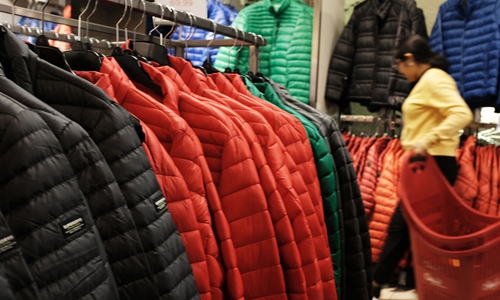HOME >> BUSINESS
China, US inject optimism on trade talks
By Wang Cong Source:Global Times Published: 2019/11/26 22:23:40 Last Updated: 2019/11/26 23:08:02
Phone call sends positive signal, but ball is in US’ court: experts

Chinese made jackets are displayed for sale at a Manhattan department store in New York City in May. Photo: VCG
China and the US on Tuesday injected fresh optimism into prospects for a highly anticipated phase one trade agreement, as top trade negotiators of both sides agreed to address remaining issues for the interim deal during a phone conversation.
Coming as speculation intensifies that the two economic powers might not be able to reach the phase one deal soon, the phone call on Tuesday morning underscored the urgency on both sides to defuse trade tensions amid rising political friction, experts noted.
Chinese Vice Premier Liu He held a phone conversation with US Trade Representative Robert Lighthizer and US Secretary of the Treasury Steven Mnuchin on Tuesday morning to exchange views on how to address each other's core concerns, China's Ministry of Commerce (MOFCOM) said in a statement.
"[The two sides] achieved consensus on properly addressing relevant issues and agreed to maintain contact over the remaining issues for the phase one trade agreement," according to the statement.
This was the first phone call between the two sides in 10 days and the third since the latest round of face-to-face trade negotiations in Washington in mid-October.
It was unclear who initiated Tuesday's call. Chinese Commerce Minister Zhong Shan and Governor of the People's Bank of China Yi Gang also listened in.
Positive signal
"The phone call shows that the two sides are still seriously pushing forward a possible phase one trade agreement, despite noise," Li Yong, deputy chair of the expert committee of the China Association of International Trade, told the Global Times on Tuesday, adding that it would be "unwise" for the two sides to reverse course for a trade deal because of recent complications.
The phone call came as market expectations for a phase one trade deal faded in recent days over a series of issues, including the US' attempt to meddle in Chinese internal affairs in Hong Kong and the US Federal Communications Commission's move to bar Chinese telecoms providers Huawei and ZTE.
Such moves have drawn harsh criticism by Chinese officials. On Monday, the Chinese Foreign Ministry summoned US Ambassador to China Terry Branstad to lodge an official protest against the US Congress' passage of the so-called Hong Kong human rights and democracy act.
"The external environment [surrounding the trade talks] is very difficult… but both sides are still trying to overcome the difficulties and strive for a historic signing of [a trade deal]," said Huo Jianguo, a vice chairman of the China Society for World Trade Organization Studies, adding both sides need a trade deal to have some "breathing room."
Huo said that the signal the officials want to send is that the two sides still have confidence in reaching a deal and "may have reached certain consensus on the most difficult issues."
While the MOFCOM's brief statement did not offer details on what had been discussed during the phone call, an expert close to the trade talks said that topics may have include tariff removals, agricultural purchases, a review mechanism for the implementation of a potential agreement as well as arrangements for a face-to-face meeting.
Still despite the positive signs, some Chinese experts stressed that China will stick to its core demands, including proportional removal of existing tariffs and a balanced text of the phase one trade agreement.
"The ball is in the US' court," said the expert close to the trade talks who spoke on the condition of anonymity.